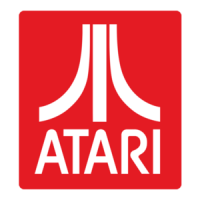Super
Breakout
allows
the
player(s)
to
select any
one
of
three
different
action-packed
Super
Breakout
games
byturningthe
game
select
knob
on
the
control
panel
to
the
desired
game.
The
three
available
Super
Breakout
games are
the
following:
•
Double
• Cavity
• Progressive
Each
game
play
is
explained
in
later
paragraphs
under
Section D.
B.
ATTRACI'
MODE(SeeFigure2-1)
The
Attract
mode
appears
in
two
different
ver-
sions.
The
first
version
occurs
immediately
after
AC
power-up
of
the
game
or
after
Self-Test.
The
second
occurs
at
the
end
of
every
game
when
there
is
no
longer any credit. The difference between these
two
at-
tract
mode versions
is
aooreciable and must be noted.
The
first
version
of
the
attract
mode
(power-up)
begins
when
AC
power
is
applied
to
the
game
and
the
power
on/off
switch
1s
tu
med
"on"
(the
power
switch
is
located
at
the
top
rear
of
the
cabinet
as
shown
in
Figure 1-4).
While
in
the
first
version
of
attract
mode,
the
TV
monitor
displays each
game
sequentially,
beginning
with
Cavity,
for
a
short
time.
It
then
proceeds
to
Double,
to
Progressive,
and
finally
returns
to
Cavity.
The
screen
does
not
display
a
paddle
but
rather
an
invisible
solid
line
at
the
bottom
of
the
TV
screen
(where
the
paddle
normally
is
displayed).
Immediately
upon
applying
AC
power
to
the
game,
the
first
attract
mode
version
is
activated
and
a
ball
is
automatically
served.
When
the
ball
is
served
it
randomly
heads
toward
the
horizontal
line;
on
im-
pact
with
this
line
the
ball
rebounds,
then
travels
towards
the
brick
wall.
The
ball hits a
brick,
the
ball
rebounds
and
the
brick
disappears
but
the
serve
does
not
change
as
a
result
of
having
a
solid
invisible
row
of
paddles
that
never
miss. This
continuous
rebound
action
proceeds
as
the
playfields
change
from
Cavity,
to
Double,
to
Progressive
and
back
to
Cavity,
drawing
the
attention
of
a passing
potential
player.
In this attract mode version the last
two
player
scores remain steadily displayed
at
the
bottom
of
the TV
monitor
screen, whereas the coin/player credit phrase
is
displayed blinking
at
the
bottom
of
the screen.
2-2
Super Breakout
phrase
is
displayed
blinking
at
the
bottom
of
the
screen.
The
sound
(or
audio)
remains
muted
during
the
attract
mode
and
neither
the
one-
or
two-player
start
pushbuttons
or
Serve
pushbutton
is
lighted.
These
switches
and
the
3-position
rotary
switch
also remain
inoperative
during
this
version
of
the
attract
mode.
The
second
version
of
the
attract
mode
occurs
at
the
end
of
every
game
when
there
are
no
longer
any
credit. When the last ball in the game
is
served and
missed, the second version
of
the attract mode appears
and
displays the last game's brick pattern (if
any).
The
paddle(s) disappear,
leaving the solid invisible horizontal
row
of
paddles and a flashing coin mode on the screen
(corresponding
to
the operator's option setting), alter-
nating
with
High Score (if
not
zero). The required
number
of
balls
for
the game being displayed are then
served and captured
to
randomly bounce against the
playfield objects and boundaries,
but
never
to
leave the
screen
or
knock
out
any bricks until the player adds
more credit
to
the game.
~--------
NOTE
---------
The
game select
rotary
switch
remains
in-
operative
until
credits
are
provided.
After
several seconds lapse,
the
first
version
at-
tract
mode
appears
on
the
screen
as
described
in
previous
paragraphs
under
this
heading.
C.
READY-TO-PLAY
MODE
(See
Figures
2-2, 2-3,
2-4)
The
ready-to-play
mode
exists
for
each
game
selection
as
illustrated
in
Figure 2-2 (Cavity), Figure
2-3 (Progressive),
and
Figure 2-4
(Double).
This
mode
is
immediately
initiated
after
the
coins
are accepted
by
the
coin
mechanism
or
at
the
end
of
a game
with
credits
remaining.
After
the
coins
are
accepted,
the
rotary
game
select
switch
becomes
active
and
the
screen
changes
from
its
current
attract
mode
playfield
display
sequence
to
the
playfield
corre-
sponding
to
the
game
select
switch
setting.
For
example,
if
the
screen displays a
Double
Breakout
while
in
the
attract
mode
and
the
game
select
switch
was set
to
either
Cavity
or
Progressive,
the
display
would
immediately
change
from
the
attract
mode
Double
game
playfield
to
the
Cavity
or
Progressive
ready-to-play
mode
playfield.
During
the
ready-to-play
mode
the
paddle(s) be-
come
visible
and
the
ball
is
no
longer
automatically
served.

